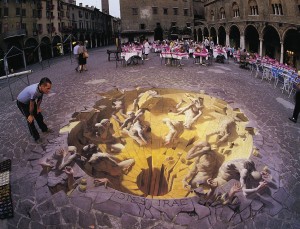The Master of Illusion: An Interview with Pavement Artist Kurt Wenner
Fumbling with your cell phone on your way to work, your alertness is unfocused as you step onto a crack in the sidewalk, leading into a gaping, yellow hole with hands and bodies sticking out, grasping for their last chance at survival. As you divert your attention away from the latest email from your boss to catching your balance before joining the morbid Dante’s Inferno scene below, you soon realize that the crevice is merely an illusion; a trickery of the mind, drawn onto the pavement by artist Kurt Wenner.
Deemed the “master artist” by his followers as well as critics and fans, Wenner has accomplished what most artists strive to achieve throughout their lifetime — an invention of a new art form known as anamorphic, or more simply put, three-dimensional pavement art, whose effect is dependent on the positioning of the viewer. Describing his concept, as perceptual with hints of invention and communication, the man who sits scrupulously bent over a tarmac surface in sunny or inclement weather with colorful chalk in hand, has brought a whole new meaning to giving life to art since its formation in 1984. Enthralled by the artwork from the Renaissance era (such as the Sistine Chapel ceiling fresco painted by Michelangelo which Wenner coincidentally touched), he meshes together classicism with contemporary in an attempt to bridge the two art worlds together, re-teaching the basics to the modern world.
This is where his true passion lives.
Despite his contribution to street art, Wenner believes that his legacy lies in the teaching of geometrical fundamentals of the art world and their place within human creativity. And his endeavors haven’t been fruitless. Awarded the Kennedy Center Medallion for his outstanding contribution to arts education involving both children and college students, he has paved the way to his current undertakings ranging from writing a second art book to holding art forums.
Yet in the midst of creating new paintings as well as dabbling in architectural work, he finds himself pressed for time to pursue this passion with the ardent cognizance it deserves.
Bringing you a little glimpse into the artist to whom the street is a canvas and Italy is a second home — due in large part to his discovery of street painting in Rome and his fascination with the classical arts — GALO discusses with Wenner his favorite work, his perception on graffiti art and Banksy, as well as his time at NASA.
GALO: Your three-dimensional artworks are stunning and evocative. One can almost feel as if the work is coming to life before their eyes. How do you achieve this effect?
Kurt Wenner: The three-dimensional street painting is my own invention. I created it by studying a type of anamorphism that existed in the 17th century. My own geometry is different from the 17th century works, and I have not published it yet. It combines a logical use of linear perspective with a projection outward from the human eye. Other artists that emulate the three-dimensional pavement works use a more traditional geometry called “quadratura” that does not involve complicated calculations. They often do not understand that my geometry is unique.
GALO: You’ve been dubbed the master architect and artist by the media. Do you feel that having been labeled as such creates a certain level of pressure or expectancy when it comes to your work?
KW: It would not be useful to let the accolades limit what I do. Pavement art is essentially a performance, and the environment has a large impact on the outcome. In the studio, I have much more control, and can afford to obsess about the details. As an architect, my major expertise is in classical proportioning. This is essentially a lost art in our time, so I can feel very confident about my abilities in this arena.
GALO: Quite a prestigious artistic outcome for someone who at first worked for NASA. Can you tell us a little bit about your time there — I believe you were an advanced scientific space illustrator at the time?
KW: I had to be able to read blueprints of fairly unusual structures and create perspective views or cross-sections from them. I had to be able to question the physicists about the properties of gasses in a particular atmosphere at a particular temperature. Then I needed to depict the result in a drawing or painting.
Nobody, but the physicist who designed the machine, could imagine what the thing would look like, as there were no blueprints yet. I basically sketched it in front of him, until it was about right, then created an appropriate perspective space and corrected the angles.
I eventually was employed at the laboratory and created artist’s renderings of future projects to Mars, Venus, and even the sun. The images were created by hand from scientific data, landscapes of outer planets, and future spacecraft. I can’t even begin to describe what the experience taught me.
GALO: Tell us about the moment you decided to leave NASA.
KW: The entire time I worked at NASA I studied classical drawing, sometimes for more than 20 hours a week. Eventually the time came when the only way to further my studies was to go to Italy and work from the masterpieces. I saw the first examples of computer graphics imaging (CGI) at the laboratory and, although the images were very primitive, I realized I would probably be the last traditional artist to do perspective renderings by hand. Because my own geometry studies were rooted in the ancient tradition of sacred geometry rather than technical drawing, I was concerned about this development. It occurred to me that the tradition and significance of geometrical drawing and design would become lost with computer graphics in the same way that the tradition of classical drawing had collapsed with the invention of photography.
(Article continued on next page)

